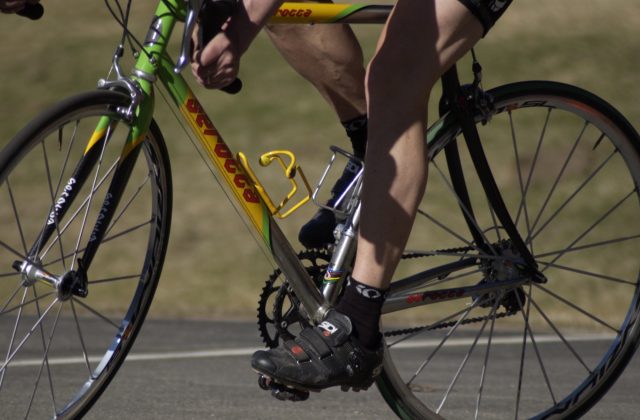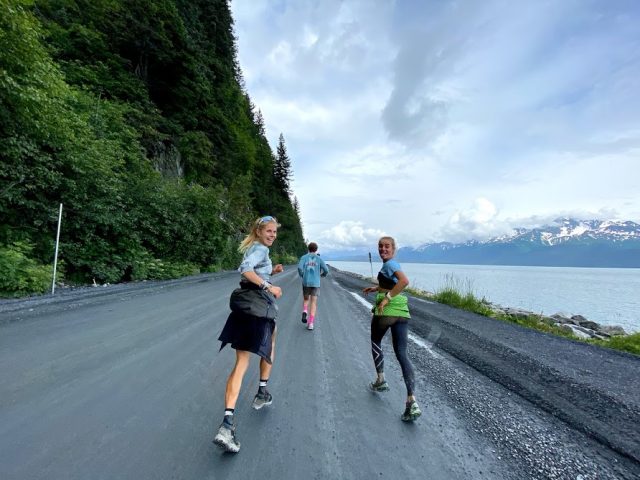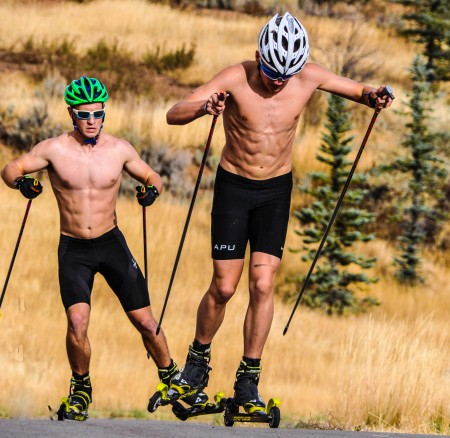
Spring is nice, spring is fun, spring is a relief after a long, cold winter. But, for diehard skiers, spring is also the new season in which we begin imagining ourselves as next year’s skiers. The snow is barely gone, but already we’re imagining futures in which we glide through snowy meadows, double pole across the flats, charge confidently up homologated uphills, and V2 boldly across finish lines. Our heads are already in next season. But, in order to realize the technical, athletic, and endurance visions we’ve conjured for ourselves, the work needs to start now. Ironically, the most efficient forms of that work are found not on skis (nor on roller skis), but in a variety of training practices that allows us to leave skis and poles in the closet for a while. Spring training begins now . . .
The physiological qualities that produce faster skiers are straightforward and simple (even more so for age-group competitors than for World Cup stars): we need endurance, and we need strength. This article will deal with the philosophies of training for endurance, with strength being addressed in a separate installment.
What is Endurance?
In the context of nordic skiing, endurance is the ability to perform ski-related movements over time in a manner that is efficient, that maintains high levels of athletic output, and that withstands athletic discomfort. Cross-country skiing is a difficult and challenging sport; those skiers who are the best possess the ability to create high levels of speed, and to maintain those levels of speed over great distances. Much of that performance results from having increased an athlete’s ability to take in, transport, and transfer oxygen. Training does that—endurance training—and the figures we use to measure such abilities are called “VO2 max.”
By now, everyone even slightly interested in athletics has heard the term VO2 max: a measure of an athlete’s ability to utilize oxygen. We typically imagine that transfer of oxygen to be occurring in the muscle cells. It does, but there’s far more to the oxygen transfer systems than just the ability of cells to suck up oxygen. Nearly as important is the delivery system; that means capillaries, tiny networks of blood vessels where oxygen exchange with the muscles place. Deliver more oxygen to the muscle cells (while simultaneously allowing those muscle cells to shed waste product), and the lactate wall that most of us run into on steep uphills becomes far easier to navigate. Fortunately, certain types of training are the best at inspiring the actual construction of new and more extensive beds of capillaries. More places where the oxygen transfer can take place, better endurance. Skiers want more capillary beds: that’s why they ski slow and easy.
For the development of endurance (and the building of new capillary beds), the exercises that are recommended are those with low resistance and fairly high RPMs (what cyclists would refer to as “spinning”). In comparing the likely forms of exercise in which skiers might engage in the spring, running is better than skiing at encouraging the growth of capillary beds, and cycling is better than either one. What about my arms, you ask? Isn’t cycling ignoring my whole upper body? Well, cycling has been shown to encourage the development of capillary beds not just in the legs, but in the muscles of all long bones (arms/shoulders included). While cycling isn’t training the particular strength aspects of your upper body, it is training those muscle systems to perform more efficiently when it comes to delivery of oxygen. And there’s always late summer and autumn to deal with training the upper body (that’s what roller skiing is for).

American World Cup competitor, Sophia Laukli, received headline coverage last year for her ability to compete at world class levels in both summer and winter seasons. Her pursuit of numerous mountain-running marathon races throughout the summer raised eyebrows in the Nordic world: would she still be able to perform in World Cup events in the winter, or would a summer of racing and run-training have burned her out? As it turns out, there was no need to worry about Laukli, as she proved by not only winning the season-long Golden Trail Series, but also won a FIS World Cup distance event (the climb up Alpe Cermis, final stage of the 2024 Tour de Ski). Laukli has already begun her running training for the trail marathon season. Needless to say, it’s unlikely she’s spending much time on roller skis these days.
One way or another, if one of my training goals is to develop greater endurance over the summer (and to create a broad endurance base that will improve my body’s ability to absorb all the training I intend to do), then my spring should begin with a considerable amount of long, slow, low resistance, high rpm activity. And there are more efficient ways to accomplish that than simply hopping back onto my roller skis.

Why Not Just Ski?
Many of us roller ski in the spring simply because we’re lonely for skiing. Well, if we ski simply for the pleasure of skiing, then roller skiing is just fine (though most would admit it’s nowhere near as pleasant as skiing on snow). On the other hand, if our commitment to skiing is such that we truly want to improve our performance, then we should investigate how best to pursue that in the off-season . . . and training on roller skis at the beginning of spring is not the only way.
Why not? Here are a few reasons for us leave our roller skis in the closet until later in the season:
- If my goal is to improve my ski performance next season, then there are better ways to achieve that than to simply continue skiing. What most skiers need is to establish an accurate understanding of their own athletic strengths and physiological weaknesses. Those are the issues to address, especially in the first half of the dryland season. We need more power; we need greater endurance; we need to generate (and hold) higher levels of speed; we need to strengthen core muscles so that our full force is applied in poling; we need to strengthen stabilizer muscles so that we can stand straight on top of the ski instead of caving in. The fastest way to accomplish those things is to put the skis away for a while, and concentrate on workouts, exercises, and disciplines that address each issue independently.
- If low resistance and higher rpm’s are two of the qualities that encourage production of new capillary beds, then skiing (and roller skiing) may not be the best exercise choice at this time of year. Even at low ski-speeds, the rpm’s of skiing are far lower than hiking, running, cycling. It may seem strange, but one of the important things to consider in your training is the plan to mix things up, to include in your training alternative activities that better suit the fitness goal. Get on the bike, go for a hike, lace up the running shoes. Plenty of time for roller skiing later in the season.
- While the athletic and physiological stresses of roller skiing are similar to skiing on snow, it’s also known that roller skiing is a quite imperfect means of practicing ski-technique. Unlike skiing on the snow, the glide on roller skis is nearly constant no matter which part of the ski is weighted, and no matter how much the wheels are tipped or tilted. Whether on skate or classic roller skis, a knock-kneed skier will roll as fast as a skier who stands directly on top of their wheels. That’s not the case on snow. On classic roller skis, the “kick” can be initiated no matter how imprecise the skier is in applying force. That’s not the case on snow. There are many such technique examples that render roller skiing quite an imperfect imitation of on-snow skiing, and too great a reliance reliance on roller skiing in the off-season is how bad technique habits can be reinforced.
Simple advice in designing the training you do in the spring: leave the roller skis in the closet a while longer, and work on fitness improvements that will make you faster next season.
John Teaford
John Teaford—the Managing Editor of FasterSkier — has been the coach of Olympians, World Champions, and World Record Holders in six sports: Nordic skiing, speedskating, road cycling, track cycling, mountain biking, triathlon. In his long career as a writer/filmmaker, he spent many seasons as Director of Warren Miller’s annual feature film, and Producer of adventure documentary films for Discovery, ESPN, Disney, National Geographic, and NBC Sports.



